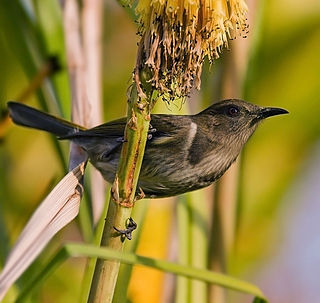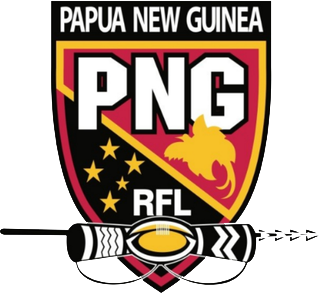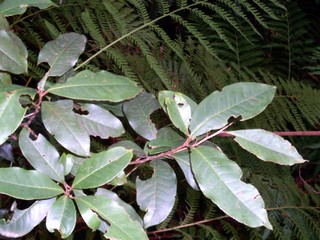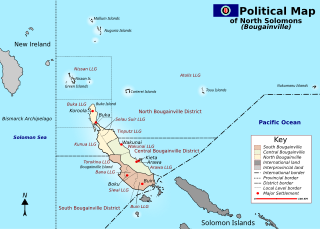
Papua New Guinea, officially the Independent State of Papua New Guinea, is a country in Oceania that comprises the eastern half of the island of New Guinea and its offshore islands in Melanesia. It shares its only land border with Indonesia to the west and its other close neighbours are Australia to the south and the Solomon Islands to the east. Its capital, located on its southern coast, is Port Moresby. The country is the world's third largest island country, with an area of 462,840 km2 (178,700 sq mi).

Rattus is a genus of muroid rodents, all typically called rats. However, the term rat can also be applied to rodent species outside of this genus.

The honeyeaters are a large and diverse family, Meliphagidae, of small to medium-sized birds. The family includes the Australian chats, myzomelas, friarbirds, wattlebirds, miners and melidectes. They are most common in Australia and New Guinea, and found also in New Zealand, the Pacific islands as far east as Samoa and Tonga, and the islands to the north and west of New Guinea known as Wallacea. Bali, on the other side of the Wallace Line, has a single species.

Huntsman spiders, members of the family Sparassidae, catch their prey by hunting rather than in webs. They are also called giant crab spiders because of their size and appearance. Larger species sometimes are referred to as wood spiders, because of their preference for woody places. In southern Africa the genus Palystes are known as rain spiders or lizard-eating spiders. Commonly, they are confused with baboon spiders from the Mygalomorphae infraorder, which are not closely related.

The Papua New Guinea national rugby league team represents Papua New Guinea in the sport of rugby league football.

Western New Guinea, also known as Papua, Indonesian New Guinea, and Indonesian Papua, is the western half of the island of New Guinea, formerly Dutch and granted to Indonesia in 1962. Given the island is alternatively named Papua, the region is also called West Papua.

Cordyline is a genus of about 24 species of woody monocotyledonous flowering plants in family Asparagaceae, subfamily Lomandroideae. The subfamily has previously been treated as a separate family Laxmanniaceae, or Lomandraceae. Other authors have placed the genus in the Agavaceae. Cordyline is native to the western Pacific Ocean region, from New Zealand, eastern Australia, southeastern Asia and Polynesia, with one species found in southeastern South America.

Nicodamidae is a family of araneomorph spiders with twenty-seven species in seven genera. They are small to medium-sized spiders found near the ground of eucalypt forest in small sheet webs. The species of this family are only present in Australia and Papua New Guinea. In most cases the cephalothorax and legs are uniformly red and the abdomen black, for which these species are sometimes called the "red and black spiders".

Foreign relations exist between Australia and Papua New Guinea. Papua New Guinea is Australia's closest neighbour and a former colony of Australia. Both nations share the same continent in the Oceania region. Papua New Guinea has developed much closer relations with Australia than with Indonesia, the only country which it shares a land border with. The two countries are Commonwealth realms. In contemporary times, Papua New Guinea is one of the largest recipients of Australian aid. Some critics have pointed to instances where this has led to an outsized Australian influence on Papua New Guinea politics.
Reginald Davani is a former Papua New Guinea footballer, who is currently acting as senior men's coach at Western Pride FC.

The continent of Oceania, sometimes known in technical contexts by the names Sahul, Australia-New Guinea, Australinea, or Meganesia to distinguish it from the country of Australia, is located within the Southern and Eastern hemispheres. The continent includes mainland Australia, Tasmania, the island of New Guinea, the Aru Islands, the Ashmore and Cartier Islands, most of the Coral Sea Islands, and some other nearby islands. Situated in the geographical region of Oceania, Australia is the smallest of the seven traditional continents.

New Guinea is the world's second-largest island, with an area of 785,753 km2 (303,381 sq mi). Located in Melanesia in the southwestern Pacific Ocean, the island is separated from Australia by the 150-kilometre wide Torres Strait, though both landmasses lie on the same continental shelf, and were united during episodes of low sea level in the Pleistocene glaciations as the combined landmass of Sahul. Numerous smaller islands are located to the west and east. The island's name was given by Spanish explorer Yñigo Ortiz de Retez during his maritime expedition of 1545 due to the resemblance of the indigenous peoples of the island to those in the African region of Guinea.

Scopulini is a tribe of the geometer moth family (Geometridae), with about 900 species in seven genera. The tribe was described by Philogène Auguste Joseph Duponchel in 1845.

New Zealand–Papua New Guinea relations refers to the diplomatic relations between New Zealand and the Independent State of Papua New Guinea. Both nations are members of the Commonwealth of Nations, the Pacific Islands Forum and the United Nations.

Notagonum is a genus in the beetle family Carabidae. There are more than 80 described species in Notagonum.

Quintinia is a genus of about 25 evergreen trees and shrubs native to the Philippines, New Guinea, New Zealand, New Caledonia, Vanuatu and Australia. Plants have alternate leaves. White or lilac flowers form at the end of stalks or on leaf axils. The fruiting body is a capsule, usually containing a large number of tiny seeds. The genus is named after the gardener Jean-Baptiste de la Quintinie.
William Warren was an English entomologist who specialised in Lepidoptera.

The Bougainville conflict, also known as the Bougainville Civil War, was a multi-layered armed conflict fought from 1988 to 1998 in the North Solomons Province of Papua New Guinea (PNG) between PNG and the secessionist forces of the Bougainville Revolutionary Army (BRA), and between the BRA and other armed groups on Bougainville. The conflict was described by Bougainvillean President John Momis as the largest conflict in Oceania since the end of World War II in 1945, with an estimated 15,000–20,000 Bougainvilleans dead, although lower estimates place the toll at around 1,000–2,000.















